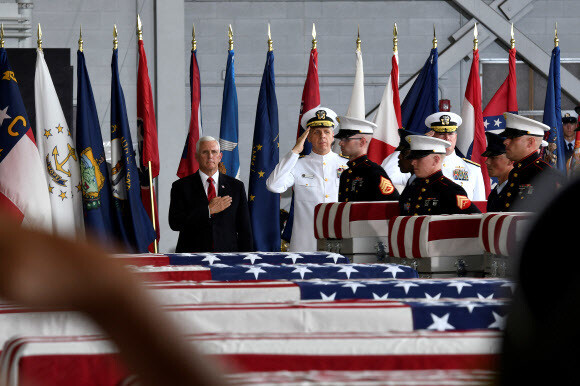hankyoreh
Links to other country sites 다른 나라 사이트 링크
[Editorial] Earlier third inter-Korean summit may break stalemate between North Korea and US

There is cautious discussion of the possibility of the third inter-Korean summit being held as early as August. On Aug. 1, the Blue House said that the decision would be made through deliberations with North Korea while noting that an early summit remained a possibility. South and North Korea’s original agreement in the Apr. 27 Panmunjeom Declaration was to hold the next summit in the fall, but the two sides appear to be considering the option of moving the timing of the summit forward because North Korea-US relations are at a standstill.
Though there has been progress in a few areas of North Korea-US relations since the summit on June 12 – including North Korea’s shutdown of its missile testing site at Tongchang Village and the repatriation of the remains of American soldiers – they’ve failed to make any significant progress on the central issue of the negotiations, namely the question of denuclearization. There has also been a delay on declaring the end of the Korean War.
We believe that South and North Korea moving the summit forward is what’s needed to break out of this deadlock. An inter-Korean summit can be used to build momentum for a change in the situation, and the South Korean government can serve as a facilitator for the denuclearization negotiations.
The reason that North Korea and the US can’t seem to gain any traction in their negotiations is that they’re talking past each other. The US wants a timetable for denuclearization, while North Korea wants to improve relations and move toward lifting sanctions. This frustrating situation needs to change, if only to enable the inter-Korean summit meeting to be held. The key is whether the US will show some flexibility in regard to its sanctions against the North.
South Korean National Intelligence Service Director Suh Hoon’s visit to the US last week appears to have been aimed at dealing with this problem. Before the inter-Korean joint liaison office agreed to in the Panmunjeom Declaration can be set up, the US must exempt the project from its sanctions. In addition to this, North Korea is pushing for the resumption of tourism to Mt. Kumgang and the reopening of the Kaesong Industrial Complex. But the US remains intransigent on the issue of sanctions. That attitude is keeping denuclearization from building momentum.
If the third inter-Korean summit is held earlier than planned, it could provide an opportunity to speed up the denuclearization process. At the same time, the US has to give at least a little ground if the inter-Korean summit is to be a success. Even if immediately agreeing to formally end the war isn’t feasible, it wouldn’t be that hard to clear away some of the barriers to inter-Korean reconciliation and cooperation projects.
If the Mt. Kumgang and the Kaesong complex issue were resolved as well, it would be even more helpful for helping the denuclearization negotiations pick up speed. Considering that US President Donald Trump expressed his gratitude to North Korean leader Kim Jong-un and his hope that the two would meet soon during the ceremony celebrating the return of the remains of American service members, we hope to hear good news about the US adopting a flexible attitude toward North Korean sanctions.
Please direct comments or questions to [english@hani.co.kr]

Editorial・opinion
![[Column] Park Geun-hye déjà vu in Yoon Suk-yeol [Column] Park Geun-hye déjà vu in Yoon Suk-yeol](https://flexible.img.hani.co.kr/flexible/normal/500/300/imgdb/original/2024/0424/651713945113788.jpg) [Column] Park Geun-hye déjà vu in Yoon Suk-yeol
[Column] Park Geun-hye déjà vu in Yoon Suk-yeol![[Editorial] New weight of N. Korea’s nuclear threats makes dialogue all the more urgent [Editorial] New weight of N. Korea’s nuclear threats makes dialogue all the more urgent](https://flexible.img.hani.co.kr/flexible/normal/500/300/imgdb/original/2024/0424/7317139454662664.jpg) [Editorial] New weight of N. Korea’s nuclear threats makes dialogue all the more urgent
[Editorial] New weight of N. Korea’s nuclear threats makes dialogue all the more urgent- [Guest essay] The real reason Korea’s new right wants to dub Rhee a founding father
- [Column] ‘Choson’: Is it time we start referring to N. Korea in its own terms?
- [Editorial] Japan’s rewriting of history with Korea has gone too far
- [Column] The president’s questionable capacity for dialogue
- [Column] Are chaebol firms just pizza pies for families to divvy up as they please?
- [Column] Has Korea, too, crossed the Rubicon on China?
- [Correspondent’s column] In Japan’s alliance with US, echoes of its past alliances with UK
- [Editorial] Does Yoon think the Korean public is wrong?
Most viewed articles
- 1‘We must say no’: Seoul defense chief on Korean, USFK involvement in hypothetical Taiwan crisis
- 2N. Korean delegation’s trip to Iran shows how Pyongyang is leveraging ties with Moscow
- 3Amnesty notes ‘erosion’ of freedom of expression in Korea in annual human rights report
- 4[Column] Park Geun-hye déjà vu in Yoon Suk-yeol
- 5‘Weddingflation’ breaks the bank for Korean couples-to-be
- 6[Reportage] On US campuses, student risk arrest as they call for divestment from Israel
- 7[Editorial] New weight of N. Korea’s nuclear threats makes dialogue all the more urgent
- 8Korea sees more deaths than births for 52nd consecutive month in February
- 9Will NewJeans end up collateral damage in internal feud at K-pop juggernaut Hybe?
- 10Why Korea shouldn’t welcome Japan’s newly beefed up defense cooperation with US